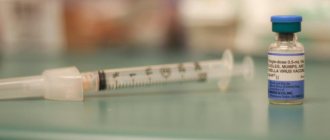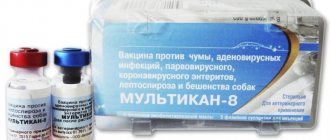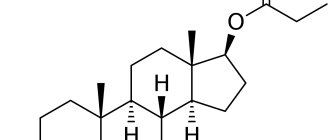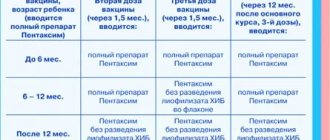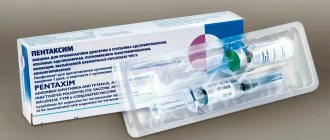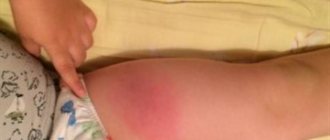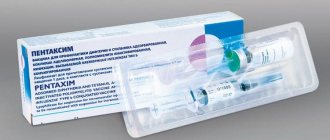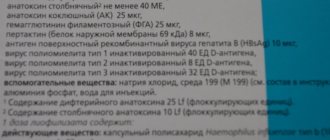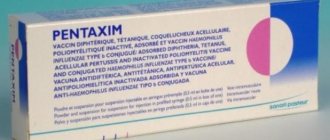Description of the drug
The Pentaxim vaccine is one of the most modern combined vaccines, which allows you to simultaneously protect a child from five dangerous infections. Pentaxim belongs to a new generation of acellular (cell-free) vaccines that replaced cellular (cellular) vaccines. Acellular vaccines are less reactogenic because are devoid of bacterial membrane lipopolysaccharides that cause reactions after vaccination. Pentaxim is a highly immunogenic vaccine, i.e. giving a high immune response of the body after vaccination.
Pentaxim is a combination vaccine containing adsorbed acellular pertussis-diphtheria-tetanus vaccine, inactivated polio vaccine and a vaccine for the prevention of Haemophilus influenzae type b. This allows one injection to immunize a child against whooping cough, diphtheria, tetanus, polio and diseases caused by Haemophilus influenzae (meningitis, sepsis, pneumonia, epiglottitis, etc.).
The presence of five components in one vaccine allows you to minimize the number of injections, thereby significantly reducing pain in the child.
First Aid Guide
Our children are inquisitive and active at any age. Unfortunately, sometimes they find themselves in dangerous situations that cannot be predicted and foreseen in advance. Of course, there are basic safety measures, but it is better to know how to provide assistance that can be applied before the doctors arrive - without harm to the child’s health.
Having mastered the primary skills of providing emergency care to children, you will not be confused at a critical moment. The most important thing in any situation is not to panic, immediately call an ambulance and correctly perform the necessary manipulations.
We offer you a guide to first aid for children. You can view the content here on the website, or you can download it to your computer or any other device.
The information collected here is important and useful.
Dear parents and our patients!
From 08/30/2021 Planned hospitalization is resuming at the State Budgetary Institution of Public Health and Clinical Hospital! For your safety, the hospital maintains measures to prevent the spread of the new coronavirus infection. In connection with this, entrance to the hospital is organized through a “Filter-pass”, where your body temperature will be measured.
Please note that planned specialized medical care at the State Budgetary Healthcare Institution IGODKB is provided only if there is a negative laboratory test for COVID - 19, carried out by nucleic acid amplification, no later than 72 hours (three days) before the planned hospitalization of the patient and caregiver him.
You must also have sufficient personal protective equipment (masks or respirators) with you for the entire period of hospitalization.
In addition, you can find out more about the procedure for hospitalization at the State Budgetary Institution IGODCCH in the section of the website “Information - Procedure for hospitalization.”
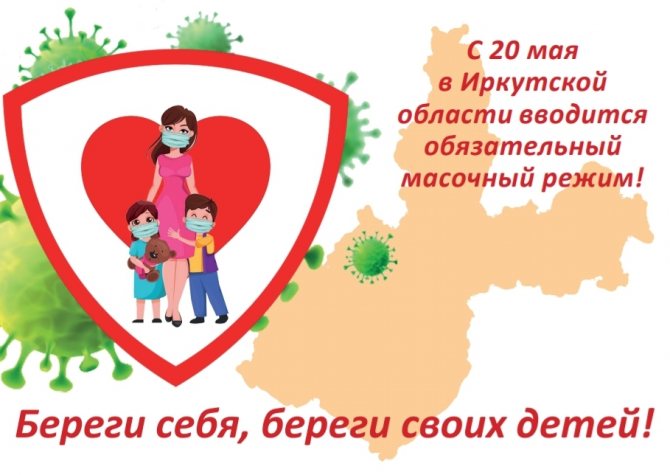
Please note that the city telephone numbers have changed in the institution of the State Budgetary Healthcare Institution IGODKB, you can find out more in the CONTACTS menu
From August 1, 2021, a preliminary appointment with specialists at the Consultative and Diagnostic Center of the Irkutsk State Regional Children's Clinical Hospital (hereinafter referred to as the CDC GBUZ IGODKB) is made on the basis of the conclusion of the Medical Commission of the clinic at the place of attachment, the decision of which is to refer the patient for a consultation to the CDC GBUZ IGODKB. A referral for a consultation is issued in the Regional Medical Information System (hereinafter referred to as RMIS) and, at the patient’s request, a printed form of referral to medical organizations of the Irkutsk region is issued, approved by order of the Ministry of Health of the Irkutsk Region dated May 22, 2013 No. 83-mpr.
We inform you that making an appointment with a doctor is carried out through the portal, which is available at the link Book an appointment with a doctor
To make an appointment with a doctor from July 1, 2021, authorization is required through an account in the Unified Identification and Authentication System (Unified Portal of State Services State Services).
Directions for use and doses
Primary vaccination is carried out according to the Russian Federation preventive vaccination calendar at 3, 4.5 and 6 months, revaccination at 18 months. On the recommendation of a doctor, vaccination and booster immunization (re-vaccination) can be carried out according to an individual schedule. A single dose of the vaccine is 0.5 ml.
If the child is not currently scheduled to be vaccinated against hemophilus influenzae, it is possible to use only the vaccine in a syringe for the prevention of diphtheria and tetanus; whooping cough and poliomyelitis, without diluting it in a bottle with a lyophilisate containing 1 dose of Haemophilus influenzae B polysaccharide conjugated with tetanus toxoid.
Does the Pentaxim vaccine contain Haemophilus influenzae?
Pentaxim is a multicomponent vaccine produced by Sanofi Pasteur. The vaccine packaging contains a bottle with lyophilisate, a syringe with an injection solution, a pair of needles and instructions for using the product.
The suspension for intramuscular administration contains the following elements:
- diphtheria toxoid in the amount of 30 IU;
- tetanus toxoid at a dosage of 40 IU;
- pertussis acellular component at a concentration of 25 mcg;
- attenuated polio virus of three types – 40, 8 and 32 units, respectively;
- acetic acid;
- filamentous hemagglutinin;
- formaldehyde;
- injection water;
- aluminum hydroxide;
- Hanks Wednesday.
Powder includes:
- Hib component in the form of a polysaccharide combined with tetanus toxoid at a dose of 10 mcg;
- sucrose;
- trometamol
The Hib component is a polysaccharide of Haemophilus influenzae type B, which contributes to the development of specific immunity against hemophilic pathologies.
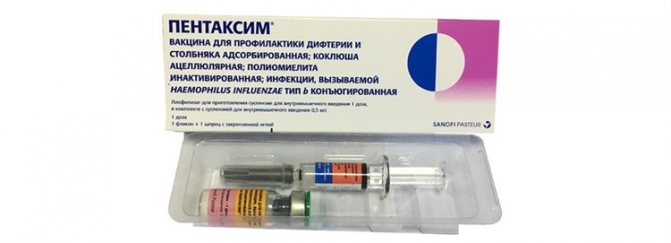
Vaccine Pentaxim
Compatibility with other vaccines
The Pentaxim vaccine can be administered simultaneously with all drugs from the national calendar of preventive vaccinations on the same day, in different parts of the body, with the exception of the BCG vaccine. The use of the Pentaxim vaccine together with other vaccinations does not affect their immunogenicity (ability to develop immunity). Tolerability of vaccines does not deteriorate, and the number of adverse reactions does not increase. Pentaxim can be used to continue and complete a course of vaccination started with other vaccines against whooping cough, diphtheria, tetanus, polio and Haemophilus influenzae.
Administering several vaccines on the same day does not place an excessive burden on the immune system. All vaccines in the Russian national vaccination calendar are interchangeable.
Pentaxim - tetanus vaccination
Last year, a unique vaccine appeared in Russia - Pentaxim . It protects children from five infections at once: whooping cough, diphtheria, tetanus, polio and infections caused by Haemophilus influenzae. One injection instead of five and fewer side effects.
WHAT'S SPECIAL ABOUT IT
The combined vaccine is good because:
a) the number of injections is reduced - instead of 2-3, only one b) the load on the immune system is reduced, since antibodies to all components are produced at one time c) from one injection the child receives 2-3 times less so-called ballast substances and preservatives
The vaccine is inactivated (consists of killed and “disassembled” pathogens), this is good because:
a) vaccination can be done on the same day with any other inactivated vaccines (for example, against hepatitis B or pneumococcus, influenza) b) the risk of vaccine-associated polio is eliminated, which is possible when vaccinated with a live vaccine virus ) there is no post-vaccination intestinal disorder d) more accurately observed dose, as it is given by injection (when live polio vaccine is injected into the mouth, the child may spit out some of it)
The vaccine has an acellular pertussis component - it has no cells, only antigens. This is good because:
a) the whole bacterium of the causative agent of whooping cough (as in the Russian DTP vaccine) has a very reactogenic shell. As a result, the temperature rises more often, neurological symptoms occur (for example, a high-pitched cry, which is believed to be caused by a severe headache) b) children with neurological diseases who have a medical withdrawal from the whole-cell DTP vaccine can now be vaccinated with the new acellular one, since they tolerate it much better.
WHAT TO EXPECT AFTER Vaccination
- In the first 2 days, redness and induration of less than 5 cm at the injection site are possible (0.1–1% of cases)
- On the first day, the temperature rises to 38°C in 20% of children, above 38°C in 1–10%, above 39°C in 0.1–1%, and even less often over 40°C. No runny nose or cough
- Irritability, drowsiness, insomnia, refusal to eat, upset stool, single vomiting, prolonged crying are extremely rare.
- As with any vaccination, there is a risk (in this case less than 0.01%) of allergic reactions, including anaphylactic ones, so it is not recommended to vaccinate yourself.
WHEN TO GO FOR A VACCINATION
The “5 in 1” vaccine fits conveniently into the calendar - it is done according to the same schedule as vaccinations against whooping cough, diphtheria, tetanus and polio, but only instead of them. As a useful bonus, the child receives protection against hemophilus influenzae infection.
If the baby gets sick (infection in the acute stage, exacerbation of a chronic disease, including allergic diseases), vaccination is postponed until his complete recovery, until his condition stabilizes.
| Pentaxim protects against diseases for 5–6 years, then revaccination is needed |
HOW TO PREPARE FOR VACCINATION
Before the first vaccination, take a general blood and urine test and consult a neurologist. Tell your doctor about your health status and illnesses of your immediate family (for example, they have allergies). For now, you can only get vaccinated against 5 ills at a time for a fee - the cost is about 2,500 rubles.
Tetanus vaccination is NOT RECOMMENDED if...
The child is over 4–5 years old: at this age a different dose is required for diphtheria and tetanus, and vaccination against Haemophilus influenzae is not given at all
There is a progressive neurological disease - this conclusion is given by a neurologist
Previously, the child had a hard time with the “5 in 1” vaccine: within 48 hours after it, the temperature rose to 40°C (not associated with a cold), there was a syndrome of prolonged unusual crying, convulsions, and hyporeactive syndrome
There were severe allergic reactions to vaccine components
A hypersensitivity reaction to glutaraldehyde, neomycin, streptomycin and polymyxin B (vaccine preservatives) was detected.
FACT
The “5 in 1” vaccine, new to Russia, has been used abroad for 12 years and has the same optimized analogues. In addition, a combined vaccine against 6 infections (plus hepatitis B) was registered in European countries 10 years ago.
WHY GET VACCINED AGAINST...
...haemophilus influenzae infection?
Haemophilus influenzae is part of the microflora of the nasopharynx and is extremely resistant to antibiotics. Its asymptomatic carriers are 5–25% of adults and 40% of children attending kindergarten. They are more likely than their peers to suffer from inflammation of the middle ear (otitis media) and a runny nose. When breastfeeding siblings become infected, in addition to acute respiratory infections, they may develop more serious infections - pneumonia, bronchitis, meningitis (from 35% to 50% of all meningitis).
The stick is transmitted by airborne droplets and through household contacts - through toys. The vaccine against hemophilus influenzae is not mandatory in Russia, but is included in the national vaccination calendars of almost all developed countries.
...whooping cough? The disease is caused by the bacterium Bordetella pertussis (whooping cough). A child is contagious a week before the onset of symptoms - a characteristic debilitating and suffocating cough. The disease is especially severe, with complications and even deaths, in children in the first year of life.
...tetanus? The pathogen enters the body through contaminated (usually soil) wounds of the skin and mucous membranes. Despite emergency resuscitation, the mortality rate reaches 25%.
...diphtheria? The disease is caused by the bacteria Coreynebacterium diphteriae. Their toxin destroys the sheath of nerves, damages red blood cells, etc. You can become infected through airborne droplets and household transmission from patients who are deceptively healthy in appearance (the infection may not manifest itself in any way for a month). The risk of death from this disease is higher in children under 5 years of age and adults over 40 years of age.
...poliomyelitis ? The causative agent is an intestinal virus, transmitted through dirty hands, water, and less often by airborne droplets. The nervous system suffers, paralysis of the legs of varying severity develops, and in severe cases, respiratory arrest occurs.
We also offer vaccinations against hepatitis B and diphtheria.
Vaccination scheme
The course of primary vaccination consists of 3 doses of vaccine and revaccination. Immunization schedule: first administration, then the second after 45 days from the first, then the third after 45 days from the second and revaccination a year after the third is completed. The use of the vaccine is not clearly related to age. It is important to comply with vaccination dates. If the deadlines are extended, vaccination will not be resumed.
Violation of the vaccination schedule can lead to a decrease in the intensity of immunity to the components of the vaccine. The hemophilic component of the Pentaxim vaccine for children over one year of age is administered once. Therefore, as soon as a child over one year old is injected with the Pentaxim vaccine with a hemophilus influenzae component, it is the last one for immunization against hemophilus influenzae infection. Further prevention of diphtheria, whooping cough, tetanus and polio with the Pentaxim vaccine in a child older than one year is carried out without the use of the hemophilic component.
Is it possible to make Pentaxim without the hemophilic component?
Pentaxim is considered a high-quality vaccine with low reactogenicity. According to reviews from parents and doctors, the drug is well tolerated and rarely causes adverse reactions. Some fathers and mothers are interested in whether it is allowed to make Pentaxim without the hemophilic component.
Reluctance to vaccinate with the Hib element may be due to the following reasons:
- intolerance to the components of the Pentaxim lyophilisate (the appearance of red spots, skin rashes, fever, convulsions, cardiac dysfunction and other side effects);
- the child has recently been vaccinated against Haemophilus influenzae; now we need to immunize him against tetanus, whooping cough, polio and diphtheria;
- parents do not want to further burden the baby’s body; they believe that the risk of infection with Pfeiffer’s bacillus is minimal.
Doctors say that immunization with Pentaxim without the hemophilic component is possible. But, when deciding to vaccinate only against tetanus, polio, diphtheria and whooping cough, one must understand that the epidemiological situation in the country is unfavorable, the child’s immunity is weakened, so the likelihood of contracting hemophilic pathology is very high.
The pharmaceutical company Sanofi Pasteur indicates in its instructions schemes for immunizing children with Pentaxim. Some of them are implemented without the Hib component. For example, when vaccinating a child aged 6 to 12 months, the third vaccination is given without lyophilisate. Prevention of children over one year of age is carried out exclusively with a suspension.
When deciding to take Pentaxim without the hemophilic component, you must consult a doctor. The doctor will examine the baby, study the vaccination history and determine the advisability of refusing to administer the lyophilisate, which protects against infection with the Pfeiffer bacillus.
How is vaccination carried out?

Vaccination is carried out in a vaccination room, in compliance with all sanitary requirements. All drugs are certified. A certificate for the drug is provided upon request.
Without reminders, before vaccination, the medical worker must show the drug and the expiration date of the vaccine.
Only sterile and disposable instruments are used. The vaccination must be carried out using disposable medical gloves.
On the day of vaccination, the child is examined by a pediatrician and the temperature is measured. In the absence of contraindications, vaccination is carried out. Information about the vaccination performed is entered into the card, vaccination certificate, and detailed recommendations for caring for the child in the post-vaccination period are given.
Before vaccination, the doctor will answer all your questions. Be sure to bring information about previous vaccinations to your appointment!
Please note that vaccination of a child, Mantoux test, Diaskintest can only be carried out in the presence of parents or legal representatives of the child (guardians), or if the accompanying person has a NOTARIZED power of attorney to carry out the manipulation (indicating the drug planned for administration) . Otherwise, vaccination will be denied. We comply with the laws of the Russian Federation.
Only here!
Is quarantine necessary after vaccination?

If parents have such an opportunity, then for several days before and after vaccination it is better to refrain from visiting kindergarten or school.
During this period, you should not invite guests home, even if they claim to be healthy, because many infections have a long latent period.
A short quarantine is not strictly necessary, however, by limiting the child’s contact with other children and strangers, mom and dad can be sure that the child’s immune system will “work” precisely to produce antigens for the components of the vaccine, and not to fight viruses and bacteria , coming from outside.
A short quarantine will ensure not only easier tolerance of vaccination, but also its greatest effectiveness.
